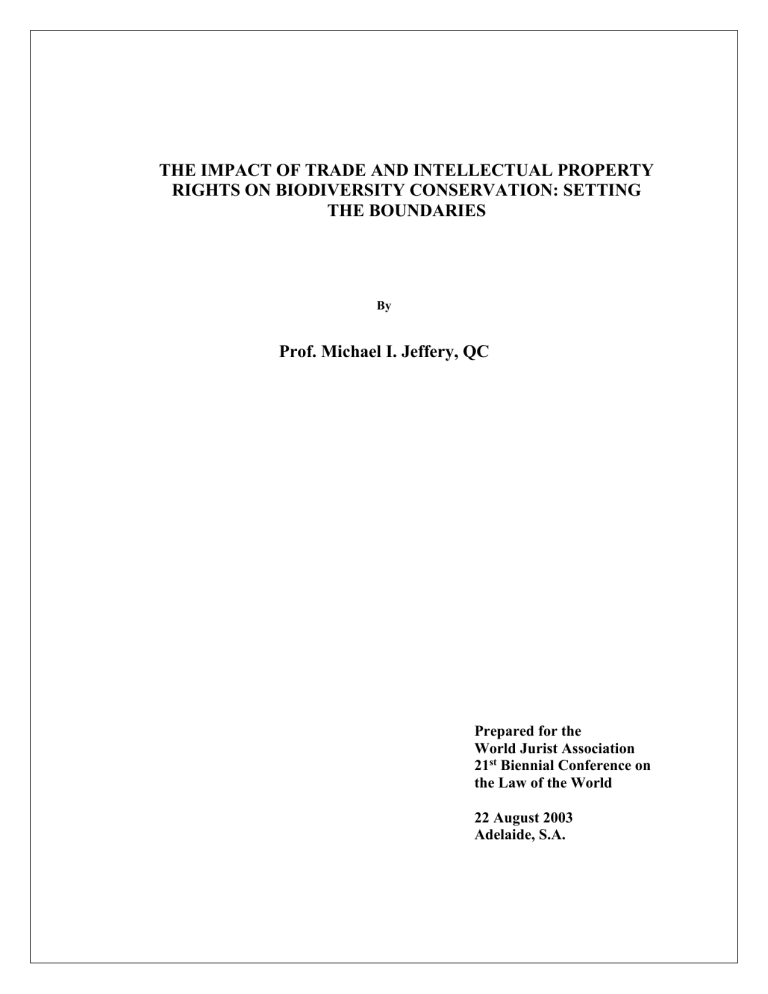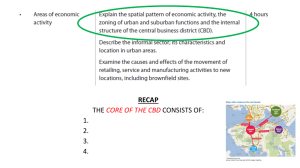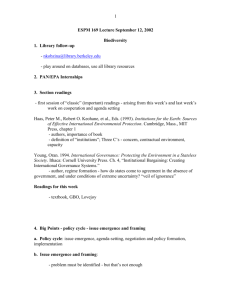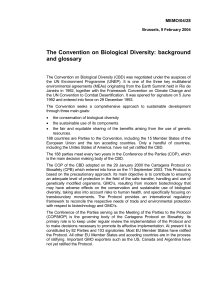SETTING THE BOUNDARIES By

THE IMPACT OF TRADE AND INTELLECTUAL PROPERTY
RIGHTS ON BIODIVERSITY CONSERVATION: SETTING
THE BOUNDARIES
By
Prof. Michael I. Jeffery, QC
Prepared for the
World Jurist Association
21 st Biennial Conference on the Law of the World
22 August 2003
Adelaide, S.A.
Introduction
THE IMPACT OF TRADE AND INTELLECTUAL PROPERTY RIGHTS ON
BIODIVERSITY CONSERVATION: SETTING THE BOUNDARIES
By
Prof. Michael I. Jeffery, QC *
A great deal has been written in recent years on the impact of trade and intellectual property rights (IPRs) on biodiversity conservation particularly in the context of the 1992
Convention on Biological Diversity (CBD). It is an issue that remains at the forefront of the biodiversity debate in part because of the fact that the negotiations leading up to the adoption of the CBD would not have been successful without the protection afforded developed nations, primarily in the North, of IPR regimes where they exist.
1
Any discussion of these issues must necessarily take into account the role of industry as a stakeholder in the context of the CBD, and as such, the driving economic force underpinning the commercial development of genetic resources. In turn, it is the fair and equitable sharing of these (profits) benefits amongst the providers of these genetic resources, including the holders of traditional knowledge that will ultimately lead to the conservation and sustainable development of biodiversity. Viewed pragmatically, the
*Professor and Director, Centre for Environmental Law, Macquarie University; Deputy Chair, IUCN –
Commission on Environmental Law.
This is a revised version of a paper presented at an IGES/IUCN/ADB Symposium “ The Second
Generation of Environmental Laws, Tokyo, 11 November 2002
1 Concerns over the treatment of IPRs in the final text prevented some developed countries from initially signing the Convention.
1
ability of existing international IPR regimes to adequately protect industry’s huge expenditures on research and development remains the key to industry participation, without which there will be neither profits to be generated nor fair and equitable benefits, including technology, to be transferred. Social justice and equity also requires new forms of legal protection for the owners of genetic resources and for traditional knowledge and practices.
This political and historical reality must be tempered, however, by a recognition of the considerable potential of IPRs to substantially undermine the benefit-sharing objectives of both the CBD and domestic access legislation while offering no protection or reward for either the traditional systems of knowledge or the stewardship of genetic resources provided by indigenous and local communities.
2
Certainly, the successful negotiation of the Agreement on Trade-Related Aspects of Intellectual Property Rights
3
(TRIPS
Agreement) was no mere coincidence. This, the most comprehensive multilateral agreement on intellectual property, sets forth the minimum level of intellectual property rights, which must be provided by all State parties to the General Agreements on Tariffs and Trade (GATT).
4
Developed countries were able to use concessions in other areas as leverage in negotiations leading up to the signing of the TRIPS Agreement.
It has been estimated that the annual global market value of commercial products derived from the following sectors alone - pharmaceutical, botanical medicines, major crops, horticulture, crop protection products, applications of biotechnology in fields other then healthcare and agriculture, cosmetics and personal care products – could exceed US$800
2 John Mugabe et al , “Managing Access to Genetic Resources: Towards Strategies for Benefit Sharing”, in
John Mugabe et al , eds., Biopolicy International Series No. 17 (Kenya: ACTS/Initiatives Publishers/WRI
1996) at 10
3 Agreement on Trade-Related Aspects of Intellectual Property Rights , 15 April 1994, Marrakesh
Agreement Establishing the World Trade Organisation , Annex 1C, Gatt Doc. MTN/FAII- A1C, 33 I.L.M.
1197 [hereinafter TRIPS Agreement].
4 General Agreement on Tariffs and Trade , 30 October, 1947, 61 Stat. A3, 55 U.N.T.S. 187 [hereinafter
GATT].
2
billion
5
and thus the importance of industry and trade to both North and South cannot be underestimated.
Although the issues of access and benefit sharing in relation to genetic resources are of fundamental importance to the effectiveness of whatever legal regimes to conserve biodiversity are put in place at the international and national levels, equally important, at least to industry, is the recognition of the legal and institutional safeguards that exist to protect their intellectual property rights with respect to the research, knowledge and innovation that must be invested to produce a commercially viable product. To suggest, however, that only industry has a vested interest in the protection of knowledge in this context is, of course nonsense, for the protection of traditional knowledge and practices of indigenous peoples, farmers and local communities remains a central issue of concern for all parties to this debate.
The relationship of IPRs to the CBD is particularly complex and fraught with difficulties, in part because the protection afforded the holders of these rights is designed to be exclusive for a defined period of time and thus has the potential to seriously impact the circumstances under which benefit sharing takes place.
Moreover, the protection of intellectual property rights has been the subject of independently developed legal regimes outside of the CBD with different rules in various jurisdictions and governed by the provisions of several international conventions and agreements such as the TRIPS Agreement, 6 and the Paris Convention. These rights are also subject to ongoing debate within influential international organizations such as the
5 Kerry ten Kate and Sarah A Laird, The Commercial Use of Biodiversity: Access to Genetic Resource and
BenefitSharing , (U.K.: Earthscan Publications Ltd, 1999) at 1. These authors roughly estimated in 1999 that the combined annual global market value of commercial products derived from genetic resources could reach this figure and noted, that although this figure is speculative is speculative, it did not cover all sectors and the vast local markets and subsistence level use of genetic resources.
6 It incorporates provisions of the Paris Convention for the Protection of Intellectual Property , 20 March
1883. U.N.T.S. No. 11851, the Berne Convention for the Protection of Literary & Artistic Works . 9
September, U.N.T.S. No. 11850 and other international intellectual property treaties.
3
World Intellectual Property Organisation (WIPO) under the auspices of the World Trade
Organisation (WTO).
The purpose of this paper is examine the impact of IPRs and TRIPS in the context of the stated objectives of the CBD and other international instruments to identify areas where they are in conflict these objectives, and to provide some suggestions as to what can be done to minimise any adverse impacts.
Nature of Intellectual Property Rights in the Context of
Biodiversity Conservation
Intellectual Property Rights are private property rights that enable the holder to exert a right for a defined period of time, to the exclusion of others, over the commercial use or exploitation of intangible intellectual information that is used to produce a certain product or embodied within a particular technology.
7
They exist in various forms such as patents, trade secrets, and copyrights and their legal status or the legal rights associated with IPRs are governed, not by international law, but by national legislation and case law and consequently varies from State to State.
For example, some States grant patent protection on a first-to-file basis (members of the
European Patent Convention) and others on a first-to-invent system prevalent in the
United States. Under the former, a patent may be granted to a new invention, that is, if it does not form part of the state of the art
8 before the filing of the European patent application, while in the U.S. a patent will not be granted where the invention was known or used by others in the U.S. or patented or described in a printed publication in the U.S. or a foreign country, before the invention thereof by the applicant for patent or was
7 Glowka defines IPRs as private legal rights that apply to intangible human contribution that goes into producing a particular technology. The holder has a legal monopoly over the commercial exploitation of the intellectual property over a specified period of time and therefore the technology that embodies it. See
Lyle Glowka, A Guide to Designing Legal Frameworks to Determine Access to Genetic Resources (Gland,
Switzerland, Cambridge and Bonn: IUCN 1998 at 1
8 State of the art is defined in Article 54(2) of the European Patent Convention to “comprise everything made available to the public by means of a written or oral description, by use, or in any other way.”
4
patented or in public use or on sale (in the U.S.) for more than one year prior to the date of application for patent in the United States.
9
That is not to say, however, that the international community has shied away from in ongoing attempts to negotiate, for example, a Patent Law Treaty capable of harmonizing the often diverse treatment afforded patent protection by countries in various parts the world. The treatment of patents internationally, however, to this point in time has been primarily through the Paris Convention for the Protection of Industrial Property administered by WIPO and the TRIPS Agreement negotiated during the Uruguay Round of the GATT that provides, inter alia , for minimum term and general enforcement obligations.
10
In recent years genetic engineering and biotechnology has placed enormous value on the information encoded in genetic resources and the incentive for IPR holders to gain intellectual property rights over genetic resources to protect this information and the processes used to extract it, has increased dramatically.
Sadly, the very nature of traditional knowledge, in a pragmatic sense, places most of it outside of the purview of IPR law and, in particular, patent protection. Unless traditional knowledge can be traced to a specific community or geographical area and has not been recorded or publicly disseminated it will likely be outside the realm of patent protection.
As Posey astutely observed, even if traditional communities were able to secure IPR patent protection for their traditional knowledge and practices, their ability to uphold these rights in the face of challenges by powerful corporations would be extremely limited.
11
The forms of IPRs most relevant to the CBD are patents, trade secrets and plant breeders’ rights and they will be discussed in the context of the relevant provisions of the CBD.
9 35 United States Code s. 102
10 Glowka et al, supra note 7 at p. 87
11 Darrel A. Posey, Traditional Resource Rights: International Instruments for Protection and
Compensation for Indigenous Peoples and Local Communities (1996) IUCN, Gland
5
It is beyond the scope of this paper to provide an in-depth discussion of patent law or any of the other forms of intellectual property rights.
Overview of Relevant Legal Frameworks i) Convention on Biological Diversity (CBD)
The CBD was adopted on the 22 nd
of May, 1992 in Nairobi and signed by over 150 States on 5 June 1992 at the UN Conference on Environment and Development in Rio de
Janeiro. It came into force on 29 December 1993.
12
It marked a change in the way nation
States approached the conservation of biodiversity for it provided a comprehensive legal framework incorporating the sustainable use of biological resources on a global basis as well as attempting to deal with contentious issues such as access and benefit sharing, the transfer of technology, including biotechnology, and the recognition that existing intellectual property right regimes have a role to play and must be integrated into the regulatory process.
As with the case of most framework treaties, the success or failure of the specific objectives set out in the CBD will ultimately depend to a large extent on the ability, including the political will, of Contracting Parties to adapt, or put into place, a legislative regime consistent with the requirements of the CBD. This is so because it is the individual Contracting States that exercise exclusive or limited sovereignty over genetic resources, and thus the responsibility falls upon each Contracting Party, from a legislative perspective, to implement the CBD.
The CBD has been widely criticised on the basis of the vagueness and ambiguity of its language, including the phrases prior informed consent and mutually agreed terms, and the ambiguity created by the technology transfer arrangements. Most commentators agree
12 United Nations Conference on Environment and Development: Convention on Biological Diversity , 5
June 1992 UNEP/Bioprospecting.Div./N7BINC5/4, 31 I.L.M. 818 (entered into force 29 December
1993) [hereinafter CBD].
6
that its interpretation will be an ongoing process by both the Conference of the Parties
(COPs) and national legislators
The nature, values and concerns resulting from the perceived global threat to biological diversity are reflected in the preamble to the Convention and its overall objectives clearly stated in Article 1. Taken together in conjunction with specific substantive articles found later in the treaty, the CBD provides a basis for the future development of this groundbreaking international legal regime, particularly in the area of customary international law.
13
(a) Preambular Pararagraphs:
The preamble to the CBD, recognizes, inter alia : the intrinsic value of biological diversity (emphasis added), as well as the importance of biological diversity (emphasis added) for evolution and for maintaining life sustaining systems in the biosphere; the close and traditional dependence of many indigenous and local communities embodying traditional lifestyles on biological resources, and the desirability of sharing equitably benefits arising from the use of traditional knowledge, innovations and practices and the vital role that women play in the conservation and sustainable use of biological diversity….;
Concern is expressed that biological diversity is being significantly reduced by certain human activity and it is specifically noted that it is vital to anticipate, prevent and attack the causes of significant reduction or loss of biological diversity at source.
13 See Glowka, L et al., (1994), A Guide to the Convention on Biological Diversity , IUCN Gland and
Cambridge, (2 nd ) at pp 1 and 7.The authors in the Guide note that the inclusion of such paragraphs in the preamble may be an important step in the development of customary international law or the specific obligations of future agreements such as protocols. They also note that the CBD represents the first time that a comprehensive rather than a sectoral approach is taken to conservation of the Earth’s biodiversity and sustainable use of biological resources.
7
Moreover, the preamble stresses the importance of, and the need to promote, international, regional and global cooperation among States and intergovernmental organizations and the non-governmental sector.
(b) Objectives
Article 1 of the CBD spells out its objectives in the following terms:
“ The objectives of this Convention, to be pursued in accordance with its relevant provisions, are the conservation of biological diversity, the sustainable use of its components and the fair and equitable sharing of benefits arising out of the utilization of genetic resources, including by appropriate access to genetic resources and by appropriate transfer of relevant technologies, taking into account all rights over those resources and to technologies, by appropriate funding.” 14
As one might expect the specific objectives set out in this Article provide the subject matter for the more detailed provisions of the Convention. Thus, the objective to conserve biological diversity is dealt with under Articles 6, 7, 8, 9, 11 and 14. The provisions relating to the sustainable use of its components are found in Articles 6, 10 and 14. Fair and equitable sharing of benefits arising out of the use of genetic resources including by appropriate access to genetic resources, taking into account all rights to those resources is the subject matter of Article 15 while the transfer of relevant technologies , taking into account all rights to technologies is dealt with under Articles 16 and 19. The obligation for Contracting Parties to provide financial support and incentives necessary to carry out these objectives and the financial mechanism for the provision of financial resources to developing country Parties are found in Articles 20 and 21 respectively.
15
14 Ibid, Art. 1
15
Glowka et al, supra note 13 at p. 15. See the Guide to the CBD for a comprehensive analysis of each
Article. As noted by Glowka et al, Article 1 provides the political reality underpinning the Convention – that of setting out the balance between conservation, sustainable use and the sharing of benefits.
See also Michael Gollin and Sarah Laird, “Global Policies, Local Actions: The Role of National
Legislation in Sustainable Biodiversity Prospecting” (1996) 2 B.U.J. Sci. & Tech. L. 16 para 7
The agreement by Contracting Parties to facilitate access to genetic resources in return for a fair and equitable share of the benefits derived from their use represents a negotiated resolution between the technology rich North and biodiversity rich South and, as such, has been termed the “Grand Bargain” of the
CBD.
8
(c) IPR-Related Provisions within the CBD
There are several provisions contained within the CBD having a bearing on IPRs either explicitly, implicitly, or in the context of national implementation. First and foremost are those provisions dealing with access and benefit sharing, and, the transfer of technology -
Articles 15 and 16, respectively.
Although Article 15 sets out the obligation for Contracting States to facilitate access to genetic resources for environmentally sound uses by other Contracting Parties and not to impose restrictions that run counter to the objectives of the CBD , it also recognizes the sovereign rights of States over their natural resources
16
, and the authority to determine access rests with the national governments and is subject to national legislation
(emphasis added).
17
Initially, Article 15 was interpreted in the context of plant genetic resources to be consistent with the accepted principle of such genetic resources being a common heritage of human kind, and thus subject to free and unimpeded access. This principle, however, may be in conflict with national legislation recognizing IPRs such as plant breeders’ rights and patents over plant varieties and genetic material
18
and thus has the potential to impose restrictions that run counter to the CBD’s objectives.
The wording of Article 15 (7) requires a Contracting Party to take legislative, administrative or policy measures, as appropriate, and in accordance with Articles 16 and 19 and, where necessary, through the financial mechanism established in Articles 20 and 21 with the aim of sharing in a fair and equitable way the results of research and
16 It should be noted that although the CBD recognizes a State’s sovereign rights over their natural resources, i.e, the right to regulate and control access, it does not confer an ownership interest. Issues relating to ownership are governed by national legislation on a jurisdiction by jurisdiction basis.
17 CBD, supra note 12, Articles 15 (1) and 15 (2); The 1983 FAO International Undertaking on Plant
Genetic Resources has been amended so as to attempt to remove some of the restrictions on the access to others of plant genetic resources.
18 See Glowka et al, supra note 13 at pp 76. 77;
9
development and the benefits arising from the commercial and other utilization of genetic resources with the Contracting Party providing such resources . Such sharing shall be on mutually agreed terms. (emphasis added). Although there is no explicit reference to IPRs in Article 15 (7), the obligation to take legislative, administrative or policy measures to facilitate the fair and equitable sharing of benefits in accordance with Article 16 requires
Contracting Parties to take these measures in a way that recognize and are consistent with the adequate and effective protection of intellectual property rights.
19
In the context of the CBD, Article 16, providing for the acess to and transfer of technology deals directly with the substantive issue of intellectual property rights.
Article 16 requires Contracting Parties to establish a framework within which to provide and/or facilitate access to and transfer of technology. It sets out the minimum requirements for all Contracting Parties whether they are the providers of the technologies or the recipients of the transfer. The method of doing so is left to the Parties.
Article 16 (1) Each Contracting Party, recognizing that technology includes biotechnology and that both access to and transfer of technology among Contracting Parties are essential elements for attainment of the objectives of this Convention, undertakes, subject to the provisions of this Article to provide and/or facilitate access for and transfer to other Contracting Parties of technologies that are relevant to the conservation and sustainable use of biological diversity or make use of genetic resources and do not cause significant damage to the environment.
20
Article 16(2) goes on to provide that access to and transfer of technology shall be provided and/or facilitated under fair and most favourable terms , including on concessional and preferential terms , where mutually agreed. Although these terms are not specially defined within the CBD, they are consistent with the use of similar language in both the United Nations Framework Convention on Climate Change (UNFCCC), the
Protocol on Substances that Deplete the Ozone Layer (Montreal Protocol) and Agenda
19 CBD supra note 12, Article 16 (2).
20 It should be noted that by defining the term “technologies” in the context of the conservation and sustainable use of biodiversity, or the use of genetic resources, the CBD ensures that traditional and indigenous applied knowledge is included.
10
21. Of importance is the recognition that where technology is subject to patents and other intellectual property rights, such access and transfer must be on terms that are consistent with the adequate and effective protection of intellectual property rights
Article 16(2).
Access to and transfer of technology referred to in paragraph 1 above to developing countries shall be provided and/or facilitated under fair and most favourable terms, including on concessional and preferential terms where mutually agreed, and, where necessary, in accordance with the financial mechanism established by Articles 20 and 21. In the case of technology subject to patents and other intellectual property rights, such access and transfer shall be provided on terms, which recognize and are consistent with the adequate and effective protection of intellectual property rights .
The application of this paragraph shall be consistent with paragraphs 3, 4 and 5 below. (emphasis added)
The following three subparagraphs of Article 16, with which Article 16(2) must be consistent, raise a number of concerns.
Article 16(3).
Each Contracting Party shall take legislative, administrative or policy measures as appropriate, with the aim that Contracting Parties, in particular those that are developing countries, which provide genetic resources are provided access to and transfer of technology which makes use of those resources, on mutually agreed terms, including technology protected by patents and other intellectual property rights, where necessary through the provisions of Articles 20 and 21 and in accordance with international law and consistent with paragraphs 4 and 5 below. (emphasis added)
Article 16(4).
Each Contracting Party shall take legislative, administrative or policy measures, as appropriate, with the aim that the private sector facilitates access to, joint development and transfer of technology referred to in paragraph 1 above for the benefit of both governmental institutions and the private sector of developing countries and in this regard shall abide by the obligations included in paragraphs 1, 2 and 3 above.
Article 16(5). The Contracting Parties, recognizing that patents and other intellectual property rights may have an influence on the implementation of this Convention, shall cooperate in this regard subject to national legislation and international law in order to ensure that such rights are supportive of and do not run counter to its objectives. (emphasis added)
Although Article 16(3) deals with the transfer of technology which makes use of genetic resources, it does not create an obligation for each Contracting Party making
11
use of the genetic resources to transfer the technology to the Contracting Party providing the resources. This Article merely provides for the establishment of appropriate legislative, administrative or policy measures that would facilitate both access and transfer of technology. Nor does it specify the manner by which this obligation is to be met and again leaves this to the parties themselves.
Article 16(3) does, however, make specific reference to technology protected by patents and other intellectual property rights. Equally significant is the fact that
Article 16(3) specifies that the obligations under this Article are to be in accordance with international law, which would include international law applicable to IPRs, namely, the TRIPS Agreement; other multilateral treaties, many of which are administered by the World Intellectual Property Organization (WIPO); other regional treaties such as the European Community Directive on the Legal Protection of
Biotechnological Inventions and a variety of bilateral agreements.
Article 16(4) extends the obligation of Contracting Parties under Article 16(3) to encourage their respective private sectors to provide access to and transfer of technology for the benefit of both government institutions and the private sector of developing countries. Once again, however, it is clear that there is no obligation forcing the private sector to actually jointly develop or transfer technologies to developing countries. If such an obligation had the force of a binding commitment as opposed to merely an aspirational objective, it is likely that many developed countries would have been discouraged from participating.
Article 16(5) found its way into the CBD in order to emphasise developed country concerns that the CBD had the potential to undermine IPR regimes worldwide. It requires Contracting Parties to cooperate in order to ensure that IPR regimes are supportive of and do not run counter to the CBD’s objectives in the context of implementing the Convention, while at the same time, tempering the degree of this cooperation by recognizing that what Contracting Parties are expected to do will be subject to national legislation and international law.
12
Just how Contracting Parties are meant to solve this dilemma remains the subject of considerable debate.
21
It should also be noted that an attempt was made in Article 22 to place the CBD in the overall context of other existing international conventions. This Article purports to ensure that the CBD shall not derogate from the rights and obligations of any
Contracting Party with respect to the rights and obligations of any existing international agreement, with the express proviso “ except where the exercise of those rights and obligations would cause a serious damage or threat to biological diversity”.
This apparent override by the CBD over other international obligations where the exercise of those rights would cause serious damage or threat to biological diversity does not extend to rights and obligations of States under the Law of the Sea
(UNCLOS).
22
The reference in Article 22 to existing international agreement(s) to which the apparent override mentioned above might apply (other than the Law of the Sea), is important for included therein is a range of international trade-related arrangements that, for the most part, do not have the conservation of biological diversity as their focus. ii ) The TRIPS Agreement
The TRIPS Agreement came into force on January 1 st 1995 and is the most comprehensive multilateral agreement on intellectual property.
23
Through this instrument,
21 It should be noted that although the aforementioned articles contain the principal provisions relating to access to genetic resources and the transfer of technology there are provisions within the CBD designed to facilitate financial and institutional capacity building within developing countries from a research, scientific, technical education, and training perspective. These are found in Articles 12, 17 and 18.
22 Article 22(2) does not contain such a qualifier. This may be because although UNCLOS did not come into force until 1994 negotiations had commenced as far back as 1973 concluding in 1982 when it was signed and a significant body of customary international law had developed with respect to the marine environment.
23 It incorporates provisions of the Paris Convention for the Protection of Intellectual Property , 20 March
1883. U.N.T.S. No. 11851, the Berne Convention for the Protection of Literary & Artistic Works . 9
September, U.N.T.S. No. 11850 and other international intellectual property treaties.
13
the scope of intellectual property rights was expanded by its association with global trade.
The Agreement sets forth the minimum level of intellectual property rights, which must be provided by all State parties to the GATT and subsumed by all member States of the
WTO. Members may implement more extensive protection provided that such protection does not contravene the provisions of the TRIPS Agreement. It would therefore be possible, for example, for a Member to enact legislation for the purpose of protecting traditional knowledge notwithstanding that traditional knowledge is not specifically mentioned.
The areas of intellectual property covered by the TRIPS Agreement are copyrights, patents, including plant variety protection, industrial designs, geographical indications, layout designs of integrated circuits, and undisclosed information, including trade secrets and test data. The Agreement affords Members a one-year grace period in order to phase in their obligations
24
. Generally, developing countries are permitted a further 4 years
25 and least-developed countries, a further 10 years
26
to implement most of the requirements under the Agreement. During such time, however, these countries nevertheless must take on significant interim obligations to protect intellectual property
27
. Articles 3, 4 and 5 include the fundamental rules on national and most-favoured-nation treatment of foreign nationals with respect to intellectual property. The national treatment provision forbids discrimination between a Member's own nationals (its citizens and corporations) and the nationals of other Members, while the most-favoured-nation treatment provision forbids discrimination between the nationals of other Members. Members are required to make available fair and equitable judicial procedures and remedies for the enforcement of
IPRs
28
.
24 Ibid.
Article 65(1)
25 Ibid.
Article 65(2)
26 Ibid. Article 66(1)
27 David Downes, “Integrating Implementation of the Convention on Biological Diversity and the Rules of the World Trade Organisation. IUCN, Gland Switzerland and Cambridge, 1999; For example, The United
States successfully challenged India’s inadequate implementation of TRIPS.
28 The TRIPS Agreement, supra note 3, Section 2 (Articles 42-49).
14
The category of intellectual property rights most likely to affect the achievement of the objectives of the CBD is patents
29
. Under Article 27, the TRIPS Agreement provides broad protection by obligating members to make patents available for both products and processes, in all fields of technology provided that they are new, involve an inventive step and are capable of industrial application 30 . This aims to stop individual countries from excluding certain material from patentability, including pharmaceuticals
31
. The
TRIPS Agreement allows Members to exclude from patentability, if they choose, diagnostic and therapeutic methods for the treatment of animals and humans; and plant, animals and biological processes for the production of plants and animals. Patents for microorganisms and microbial processes however, must be provided for.
32
In addition,
Article 27(2) enables Members to exclude products or processes from patentability within their territory of commercial exploitation, if such exclusion is necessary to protect public order or morality, including to protect human, animal or plant life or health or to avoid serious prejudice to the environment
33
. These exclusions, however, are subject to the national treatment principle provision that forbids governments from treating foreign goods differently than domestic goods
34
.
As a result of the provisions in Article 27, a number of developing countries are finding it necessary to revise their patent laws to remove exceptions from patenting for certain categories of technology such as pharmaceuticals
35
. Further, it has been noted that while there is discretion as to whether to patent plants or animals, countries may well come under increasing trade pressure to allow patents in these areas
36
.
29 These patents include plant variety protection. David Downes, supra note 24, notes that geographic indications and trade secrets may also be relevant
30 The TRIPS Agreement, supra note 3, Article 27 (1)
31 See Maria Kruger, “Harmonising TRIPS and the CBD: A Proposal from India”, (2001) 10 Minn J.
Global Trade 169
32 The TRIPS Agreement, supra note 3, Article 27(1) and 27(3)(a) and (b). This Article also requires countries to protect plant varieties either through patents or an “effective sui generis system” or both.
33 Such exclusion, however, may not be made merely because their law prohibits such exploitation .
34 Maria Kruger supra note 31
35 David Downes supra note 27
36 Klaus Bosselmann, “Focus: Plants and Politics: The International Legal Regime Concerning
Biotechnology and Biodiversity” (1996) 7 Colo. J. Int’l Envt’ L & Policy at 126-128 Countries within
Europe are finding that local biotechnological industries are considering relocating to United States because of its more liberal view on biological patents. Bosselmann suggests that the law in the European Union relating to patents over living organisms may well change to "catch up" with the United States.
15
Some developing countries have argued for an amendment to the TRIPS Agreement to ensure that there is fair and equitable benefit sharing arising out of the use of genetic resources and that protection is offered to traditional knowledge. Such issues were addressed in the CBD but have been overlooked in the TRIPS Agreement, resulting in potential conflicts. Brazil, for example, has suggested Article 27(3) should be amended in order to include the ‘possibility of members requiring, whenever appropriate, as a condition of patentability; the identification of the source of the genetic resources; the related traditional knowledge used to obtain that material; evidence of fair and equitable benefit-sharing; and evidence of prior informed consent from the Government or the traditional community for the exploitation of the subject matter of the patent’
37
.
Such amendment would potentially shift to developed countries the burden of ensuring that prior informed consent has been obtained consistent with a developing country’s access legislation. A possible amendment to this affect however, has met with the criticism that it would amount to a ‘legal and administrative nightmare’ for developed countries
38
. In addition some developed countries have called for a possible revision of
Article 27(3) to expand the exception from patenting to include micro-organisms as well as plants and animals while conversely, some developed countries have argued for the exception for the plant and animal patenting to be removed 39 . The outcome of a review of
Article 27(3) will certainly impact upon the national legal regimes regulating the access to genetic resources and the fair and equitable sharing of benefits derived from their use
40
.
37 David Hunter et al , International Environmental Law and Policy , 2 nd ed. (New York: Foundation Press,
2002) at 967
38 Ibid. Such criticism has been made by the United States.
39 David Downes supra note 27 at 101
40 Graham Dutfield, “Intellectual Property Rights, Trade and Biodiversity:”, (UK: Earthscan
Publications/IUCN, 2000) at 41, notes that while there are serious difficulties in reconciling the objectives of the CBD with the TRIPS Agreement, the implementation of the CBD cannot wait for a patent-free world. “It is far better to work with existing IPR regimes or propose realistic reforms while remaining cognisant of the pitfalls and limitations of IPRs as a means to further CBD implementation”.
16
The TRIPS Agreement makes no provision for the sharing of benefits with local and indigenous communities and to do so would require IPR laws to have stringent norms of disclosure on country and community from which patentable subject matter and information regarding its use were obtained as well as proof of consent of the provider country.
41 Interestingly, the Committee on Trade and Environment (CTE) of the WTO has stated that the fact that the TRIPS Agreement does not address benefit sharing with local and indigenous communities would not preclude bilateral arrangements between
States and companies to ensure such sharing, provided that these arrangements are compatible with it.
42 iii) Trade Secrets
In cases where the holder of information does not wish it to be publicly disclosed or for other reasons is unable to protect it by patent, this information may nevertheless be protected from disclosure under trade secret law. This form of IPR differs from patent protection in that it does not grant exclusivity in the holder for a defined period and would not prevent others from developing and using the same information through means other than having improperly obtained the information protected as a trade secret. In the context of a regulatory framework, trade secrets are almost invariably dealt with in conjunction with unfair competition and unfair trade practices.
43
Since trade secrets involve the protection of information, the range of this information is very wide and can encompass scientific information as well as traditional knowledge.
This is of particular importance to for indigenous and local communities in the context of
Article 8j of the CBD where knowledge is collected informally over generations and communicated orally in the form of the community’s oral history.
41 R. V. Anuradha, Between the CBD and TRIPS: What IPRs Mean for Local and Indigenous Communities in Biswajit Dhar et al supra at note 16 at p.79
42 CTE, (1995) Committee on Trade and Environment of the World Trade Organization, 8 June, 1995.
“Environment and TRIPS”, WT/CTE/W/8 at p. 23.
43 See also Article 39 of the TRIPS Agreement, supra note 3, requiring member States to protect trade secrets and Article 10 bis of the Paris Convention
17
Article 8(j ). Each Contracting Party shall, as far as possible and as appropriate, subject to its national legislation, respect, preserve and maintain knowledge, innovations and practices of indigenous and local communities embodying traditional lifestyles relevant for the conservation and sustainable use of biological diversity and promote their wider application with the approval and involvement of the holders of such knowledge, innovations and practices and encourage the equitable sharing of the benefits arising from the utilization of such knowledge, innovations and practices.
As noted above, the intellectual property associated with traditional knowledge and practices will likely be beyond the protection of patent law regimes.
Dutfield makes the point, however that “this Article seems to affirm that the holders (‘subject to national legislation’) have rights over their knowledge, innovations and practices, whether or not they are capable of being protected by IPRs. If they are not capable of being protected by the existing IPR system, there is still an obligation for governments to safeguard these entitlements through a new IPR law or by other legal or policy measures
.” 44
(emphasis added).
There have been several well-documented cases, almost all of them involving US patents, where indigenous and local community knowledge has been misappropriated through the use of IPRs. The more notorious examples include:
The process of extracting oil from the Neem tree - A patent granted by the
European Patent Office to the US Department of Commerce and W.R. Grace
Corp. for the process used to extract oil from the Neem tree in India was overturned in Europe in 2000 after a successful challenge by organizations representing local communities;
45
A method of promoting healing of a wound by administering Turmeric to a patient – A patent was granted by the US Patent and Trademark Office to researchers at the University of Mississippi Medical School for the use of
Turmeric to heal wounds although it had been used for centuries in India for its medicinal and culinary qualities and by followers of traditional medicine.
46
44 Graham Dutfield, “Intellectual Property Rights, Trade and Biodiversity:”, supra note 40 at 41,
45 See Hunter et al, supra note 37 at p. 965 for a full account of this example.
46 See WWF/CIEL Joint Discussion Paper – “Biodiversity & Intellectual Property Rights: Reviewing
Intellectual Property Rights in Light of the Objectives of the Convention on Biological Diversity”, Gland and Geneva, Switzerland 2001, at p. 6; see also Graham Dutfield, Background Paper, (written for the IUCN
18
The use of the Ayahuasca vine – A US patent granted to a US citizen over a variety of the Ayahuasca vine used for generations by Indigenous peoples in the
Amazon for ceremonial and healing purpose was overturned in 1999 for lacking novelty.
47 iv) Plant Breeders Rights
The regulatory regime at the international level with respect to plant breeders’ rights
(PBRs) is centred around the International Convention for the Protection of New
Varieties of Plants as amended. Known as the UPOV Convention (The Union for the
Protection of New Varieties of Plants)
48
strongly supports the rights of plant breeders and the 1991 version of the Convention has been considered by some developed countries as the effective sui generis system for the purposes of Article 27(3)(b) of the TRIPS
Agreement as it provides sui generis protection and provides for technical assistance.
The original version of the Convention had the effect of creating a “farmers’ privilege”, however some limitations of this privilege were placed on this privilege in the 1991 version and respect for the privilege was placed in the discretion of the individual State.
49
Farmer’s privilege refers to the right of farmers to save seeds of protected varieties after harvest for later replanting. Several concerns with UPOV 91 have been expressed by commentators, including the following:
the ‘perceived’ optional application of the Farmer’s Privilege may limit the right of the farmer to exchange and save seeds and thus runs counter to the CBD’s goal
Project on the Convention on Biological Diversity and the International Trade Regime), “Intellectual
Property Rights, Trade and Biodiversity: The Case of Seeds and Plant Varieties”, IUCN, Gland,
Switzerland, June 1999 at p. 43.
47 Ibid.
48 The original Convention came into force in 1961 and was amended in 1978 and 1991. The 1991
Convention has been in force since 1999.
49 Glowka et all, supra note 7 at p. 88 points out that although the 1991 text extends the PBR to all production, thereby eliminating the Farmers’ privilege (Article 14(1), UPOV members may in their national legislation limit the scope of PBRs and thus recognize a farmers’ privilege if they choose to do so.
19
of promoting the conservation and sustainable use of the components of biological diversity;
the perceived optional application of the privilege may be inconsistent with the preservation of traditional practices;
seed companies obtained very significant increases in their rights under the 1991
Convention by being allowed to use or breed with “essentially derived varieties” that are closely related but which are not be exactly the same as the protected varieties. This may be inconsistent with appropriate protection of farmers’ rights over the food supply.
UPOV 91 protects only sufficiently “stable” and “uniform” varieties and thus disregards traditional varieties that preserve greater genetic diversity.
50
The extent of the kind of controversy that can arise with IPR-related issues in the context of technology development is illustrated by Dutfield in the case study entitled “The
Technology Protection System (‘terminator technology’) Patent” outlined below:
In March 1988, the U.S. Department of Agriculture (USDA) and Delta & Pine Land Co. were awarded a US patent entitled “Control of plant gene expression”. The technology described in the patent can produce transgenic plants with a “lethal gene” whose seeds are incapable of germinating. In this way, accidental reseeding, escape of crop plant to areas outside the area of cultivation, or the germination of stored seed can be avoided.
The principal purpose of the technology is to make it impossible for farmers to save, replant or sell seed. Consequently, they will have to purchase seed at the beginning of each planting season. The USDA acknowledged that the main aim of the technology was to widely license it and made available to seed companies in order to increase the value of proprietary seed owned by US seed companies and to open up markets in Second and
Third World countries.
50 Ibid, See Glowka et al for a comprehensive discussion of PBRs at p 88; see also WWF/CIEL Joint
Discussion Paper – “Biodiversity & Intellectual Property Rights: Reviewing Intellectual Property Rights in
Light of the Objectives of the Convention on Biological Diversity”, supra note 46 at p. 16.
20
This patent and technology protection system was widely condemned as being profoundly immoral on the grounds that it would fundamentally change the biology and economics of agriculture to the detriment of the poor and was one that robbed farming communities of their age-old right to save seed and their role as plant breeders.
51
The International Undertaking on Plant Genetic resources for Food and Agriculture (IU), a non-binding Agreement under the auspices of the United Nations Food and Agriculture
Organization (FAO), is also of relevance to both the CBD and the TRIPS Agreement. Its objectives are the “conservation and sustainable use of plant genetic resources for food and agriculture and the fair and equitable sharing of the benefits arising out of their use, in harmony with the Convention on Biodiversity, for sustainable agriculture and food security.
52
Sharing almost the identical objectives of the CBD itself, some commentators predict that the IU may soon form the basis of a binding protocol to the CBD or be adopted as an agreement for the implementation of the CBD, or as an Agreement linked to the constitution of the FAO.
53
There remains, however some formidable obstacles to harmonization of the two instruments, for the IU proceeds from the principle that plant genetic resources are a common heritage of humankind, while the CBD, as noted earlier, incorporates the notion of State sovereignty over genetic resources. (Article 15(1). The CBD has recently acknowledged the special nature of agricultural biodiversity in need of distinctive solutions.
54
51 See Dutfield, supra note 46 at p. 33
52 Fifth Intersessional Meeting of the Contact Group Rome, Composite Draft Text Commission on Genetic
Resources for Food and Agriculture, International Undertaking on Plant Genetic Resources for Food and
Agriculture, 5-10 February (2001) FAO Doc CGRFA/CG-5/01/2 Article 1.1
53 See WWF/CIEL Joint Discussion Paper – “Biodiversity & Intellectual Property Rights: Reviewing
Intellectual Property Rights in Light of the Objectives of the Convention on Biological Diversity”, supra note 46 at p. 14.
54 See Report of the Second Meeting of the Conference of the Parties to the Convention on Biological
Diversity , UNEP, Conference of the Parties to the Convention on Biological Diversity (1995) Doc.
UNEP/CBD/2/19 Decision 11/15.
21
Where to from here?
As with any framework treaty, the manner in which it is implemented at the national level determines to a large extent whether or not its objectives will be achieved. The development of clear guidelines providing guidance and setting minimum requirements with respect to CBD obligations would be a good starting point and there has been some significant developments to date in this area.
A significant achievement of the CBD COP VI held in Bonn in 2002 was the adoption of guidelines on access to genetic resources and fair and equitable sharing of the benefits arising out of their utilization. Decision VI/24 known as the Bonn Guidelines
55
will be useful in providing Parties, Governments and other stakeholders in developing appropriate strategies, particularly when designing and implementing legislative, administrative or policy measures on access and benefit-sharing and/or when negotiating contractual arrangements for such activities.
The guidelines provide, inter alia
, “Draft Elements for an Action Plan for capacity-
Building for Access to Genetic resources and Benefit-Sharing”
56
which contains several provisions with respect to the role of IPRs in the implementation of access and benefit sharing arrangements. Time and space constraints will not permit a detailed discussion of these provisions. However, it is a meaningful attempt to highlight the concerns over the role of customary laws and practices in relation to the protection of genetic resources and traditional knowledge, innovations and practices, and their relationship with intellectual property rights . Under this draft Action Plan, The Conference of the Parties invites Parties and Governments to encourage the disclosure of the origin of relevant traditional knowledge innovations and practices of indigenous and local communities relevant for the conservation and sustainable use of biological diversity in applications for intellectual property rights, where the subject matter of the application concerns or
55 Conference of the Parties to the Convention on Biological Diversity, Access and Benefit-Sharing as
Related to Genetic Resources, Bonn Guidelines on Access to genetic Resources and Fair and Equitable
Sharing of the Benefits Arising out of their Utilisation , U.N. Environment Programme, 6 th mtg, U.N. Doc.
UNEP/CBD/COP/6/24 (2002).
56 Ibid Annex (Section C).
22
makes use of such knowledge in its development
57
(emphasis added) and requests the
Executive Secretary with the help of other international organizations such as the World
Intellectual Property Organization (WIPO), and through the Ad Hoc Open-ended Inter-
Sessional Working Group on Article 8(j), to undertake further information gathering and analysis with regard to a number of issues impacting on the implementation of specific articles within the CBD. Foremost amongst these is the impact of intellectual property regimes on access to and use of genetic resources and scientific research . 58
Parties to the both the CBD and the IU should encourage the FAO to further negotiations to turn the IU into a binding agreement and consider appropriate ways for it to be better integrated with the CBD, either as a protocol to the CBD or perhaps as an agreement for its implementation and as WWF and CIEL recommended in their joint discussion paper the IU and the CBD should be granted observer status in the TRIPS Council on a permanent basis.
59
Further steps must be taken to ensure the full participation of indigenous and local community leaders in the development of strategies to protect traditional knowledge and such leaders must be included as participants at international for a where the integration of IPR and biodiversity issues are discussed.
Concluding Comments
Whether or not the regimes established for the protection of intellectual property rights have the capability of undermining the stated objectives of the Convention on Biological
Diversity is, in a practical sense, of little import. IPRs are not going to magically disappear nor are the serious consequences facing humankind from the increasing loss of biodiversity. Rather, it is incumbent upon all parties to this debate to clearly identify both real and potential areas of conflict between the two and seek to find effective workable solutions that minimize to every extent possible the adverse impacts of IPRs on
57 Ibid Section C – 2.
58 Ibid, 3(a).
59 WWF and CIEL Joint Discussion Paper, supra note 46 at pp. 19, 20, 21.
23
biological diversity. The challenge facing us at the present time to find the best way of maintaining a proper balance between effective conservation and sustainable use of genetic resources and the provision of necessary incentives to encourage technological innovation and to provide a sound basis for the transfer of technology and the equitable sharing of benefits between North and South from such use.
Many argue that IPRs in fact stimulate both investment and interest in natural products and when the provisions of the CBD dealing with access and benefit sharing are properly observed by both the providers and users of the resources, the result can support both national and local capacity building and conservation.
60
As Dutfield has noted, corporations tend to be more willing to transfer proprietary technologies to countries where those technologies can be protected tan to those where IPR protection is unavailable or inadequately enforced.
61
Others have viewed the extension of IPRs to cover life forms, such has occurred in the US, not only act as a disincentive to biodiversity but are directly harmful to biodiversity and maintain that patents legitimate and support biopiracy.
62
Downes points out that the CBD takes a markedly different approach to trade and environment. For the first time this convention recognizes the principle of ecological economics that the “ecosystem contains the economy” and thus the CBD places trade squarely within its ecological context. While affirming the value of the genetic resources trade the Convention insists that trade be sustainable within the context of a sustainable process of production. Genetic resources are the raw material for “a process of production that extends from rainforests and coral reefs to drug stores, factories and supermarkets”
The CBD establishes basic rules for each stage of that process, rather than banning it altogether.
63
60 See for example, Walt Reid et al., A New Lease on Life, in Biodiversity Prospecting: Using Genetic
Resources for Sustainable Development (W. Reid et al., eds., 1993) at pp, 6, 7, 12-18;
61 See Dutfield, supra note 46 at p. 27
62 Ibid.
63 David Downes, Global trade, Local Economies and the Biodiversity Convention, in W. Snape, ed.,
Biodiversity and the Law (found in Hunter et al, supra note 37 at p. 969).
24
Whilst there is a good deal of truth in Downes’ statement, it must also be recognized that
IPR regimes have, by and large, been developed over many decades by wealthy, industrialized countries in the North to primarily to serve the interests of their politically powerful industrial sectors. These regimes are well entrenched and the objectives of the
CBD, whilst laudable in themselves, nevertheless, at least at the present time, resemble the poor cousin in the relationship when in conflict with IPRs. Encouragingly, that is slowly changing, but there is much yet to be done to achieve the elusive goals of the sustainable use of biological resources and the equitable sharing of benefits.
* * * * * * *
25








